By Christopher R. Bartocci
The 7.62x39mm cartridge is by no means new to the AR platform – clearly going back to the 1980s. Traditionally, all that was changed was the bolt, barrel and magazine. The bolt was a modified 5.56mm bolt to accept the larger 7.62x39mm cartridge base and the magazine was modified to a curved configuration to go along with how the cartridges stack due to the taper on the cartridge case. Since that introduction, rifles and conversions into the 7.62x39mm caliber have been sold by Colt, ArmaLite, Rock River Arms, Olympic Arms, PWS, YHM and Bushmaster to name just a few. With the increased popularity of AR-15 rifles, many now custom build their own using a variety of components.
There have been two major problems that have plagued this AR-based 7.62x39mm rifle. First is the magazine and second is the bolt itself. The taper on the 7.62x39mm cartridge case is excessive causing the curved AK magazine. The “banana” magazine is not made for looks but the curvature is an accurate representation of the cartridge stack of 15 rounds. The magazine well of the AR-15 is straight and since the 7.62x39mm cartridges are tapered the rounds do not sit in their natural position. When high capacity (30-round) magazines are made the top part is straight and then curves. There is no natural feeding in the magazine which has, and still causes, reliability issues with the rifle. This has plagued every rifle made over the years.
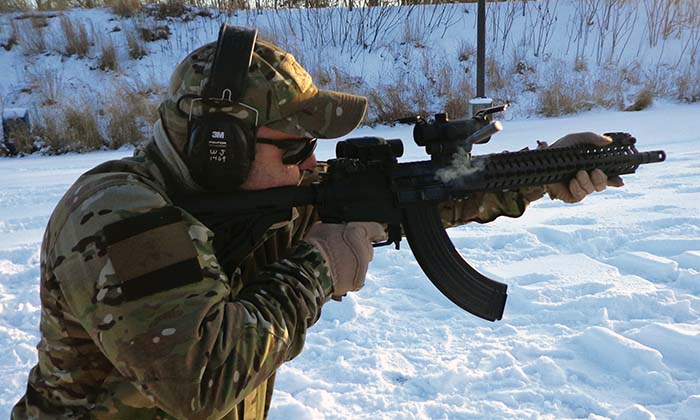
The next major problem is the strength of the bolt. In order to chamber the 7.62x39mm cartridge, additional material had to be removed from the breech face area drastically reducing the wall thickness of the supporting area of the bolt. Improving this has been quite difficult. Some manufacturers have gone to stronger materials for this bolt. Due to interchangeability, it was not an issue to increase the overall diameter of the bolt.
Prior to September 11, 2001 the 7.62x39mm chambered AR was only a commercial rifle as there was no demand for a military grade rifle. Right after the terrorist attack on the twin towers, SOCOM realized there would be combat in the Middle East and put out a call for a 7.62x39mm caliber rifle (SPR-V) of the basic M16 style. The thought would be using special operations forces in the area, they would be able to be equipped with this new rifle and when they were cut off from resupply they could pick up magazines from AK47 rifles off the field and use them. Three companies submitted rifle. This was Knight’s Armament Company (KAC), Lewis Machine and Tool and Robinson Armament. The final two were the Robinson Arms RAV-02 and the Knights Armament SR47. The SR47 held to the M16/M4 platform while the Robinson rifle held more to the original Stoner weapon system. Both however, utilized AK47 magazines.
The SR47 was designed to be basically an M4 chambered in 7.62x39mm with the same stock assembly and operating controls. The lower receiver did use the AK47 magazine. This was critical not only for the ability to pick up magazines and ammo off the battlefield and use them but also to create a reliably feeding rifle. That magazine was designed specifically to feed this tapered cartridge. The bolt carrier group was chrome plated and is the standard bolt carrier with a modified bolt for the larger rim. The magazine catch was still on the right side rather than below the receiver in front of the trigger guard. The rifle did have a bolt catch unlike any before or after it. The rifle had a KAC free float rail system allowing use of all SOPMOD accessories. The muzzle was topped off with an A2-type compensator that would also accept a KAC sound suppressor. The upper receiver had a forward bolt assist, fired cartridge case deflector as well as an ejection port cover. The rear of the receiver also had a receiver endplate that would accept QD sling mounts. The rifle weighed 7.7 pounds and with the stock closed measured 28 1/2 inches and with stock open 32 1/2 inches long. Only 6 of these rifles were bought and used by SEALS in the trials. The trials ended without a definitive winner and contract. Unfortunately the weapons were never developed and fielded. There was and still is much interest in the SR47 from a commercial stand point but Knight’s never went into production.
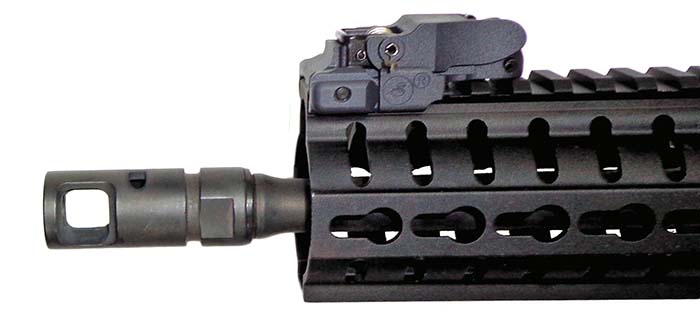
When CMMG went to make their 7.62x39mm rifle, they took lessons learned from the past in both magazine and bolt related issues and built their rifle to solve the two biggest problems. The rifle spawned was the Mk47 Mutant. Introduced December 1, 2014, the Mk47 delivered a new take on an old design (SR47) and even improved on that.
Beginning with the bolt, CMMG decided not to worry about commonality with the standard AR-15 receivers but to design receivers that would work best with this caliber rifle. They increased the receiver size to about right in the middle between an AR-10 and an AR-15. This made it possible to use a larger barrel extension thus a larger bolt head. The bolt on the Mk47, unlike all of its predecessors was not based on the AR-15 bolt but the larger 7.62x51mm bolt. This drastically increased the strength all the way around. The ejector is larger as well as the extractor. The extractor actually holds more of the rim and uses an extremely heavy duty spring. It has two embedded extractor springs along with two rubber O-rings.
The bolt carrier itself is the size of the AR-10 type but shorter in length. The carrier key is staked in place. The carrier has the four gas vents of the AR-10 rather than the three of the 5.56mm. There are no forward assist notches due to there being no forward assist. None of the components of the bolt carrier group are interchangeable with the AR-15 or the AR-10.
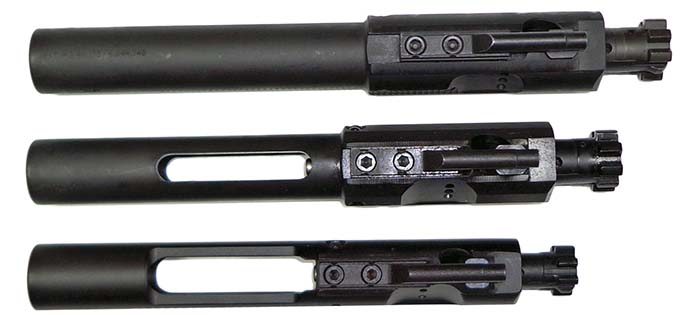
The upper receiver is cut from a billet of 7075-T6 aircraft grade aluminum. The receiver and the charging handle are unique to this rifle. The receiver is equipped with a fired cartridge case deflector as well as an ejection port dust cover similar to the M16/M4. On top of the receiver are Mil-Std 1913 rails. Cut into the receiver are extended feed ramps. The receiver is black anodized to a flat non reflective black.
The barrel is 16.1 inches long and rifled with a 1 turn in 12 inch twist. The barrel would be considered a lighter profile to reduce weight. The carbine length gas tube is held in place by a low profile gas block and is held on by two set screws. The rifle is direct gas rather than the long stroke piston of the AK47. The barrel extension is larger in diameter to accept the larger and more durable bolt. The barrel extension has two extended feed ramps that mate up with the cuts on the upper receiver.
The rail used is a CMMG RKM KeyMod. The top rail offers a constant Mil-Std 1913 from the charging handle to near the muzzle. This would allow any optic and/or night vision to be installed. KeyMod rails may be placed wherever required on the 3, 6 and 9 o’clock sides of the rail. For accessories that are not yet KeyMod compatible, CMMG offers 5-slot accessory rails. The rail is manufactured from 6061-T6 aluminum and hard coat anodized to flat black. This particular test rifle has a 15 inch rail.
The muzzle device is also a little on the hybrid side as well. The SV brake has a similar look to the muzzle brake found on the 5.45x39mm AK74. There are two vent holes on the top of the muzzle brake directing gas to the top and sides along with the larger brake in front. This is an extremely effective system for decreasing recoil, lesson muzzle rise and assist with faster multiple follow-up shots. However, muzzle noise in increased.
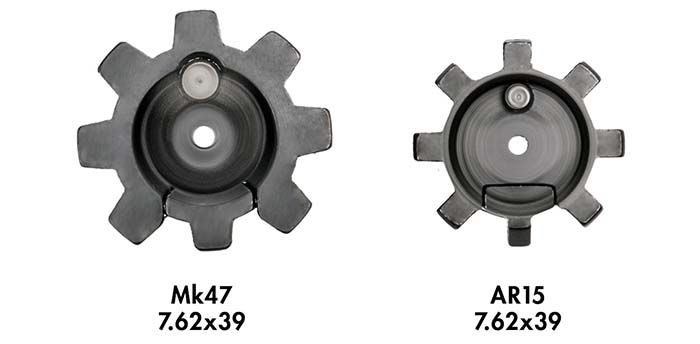
The lower receiver is also manufactured from 7075-T6 aircraft grade aluminum and hard coat anodized to a flat black color. The magazine well is cut out to accept any standard AK47/AKM type magazines. The forward magazine catch is manufactured as a steel pin inserted into the aluminum receiver for durability and reliability. The magazine release is located in front of the trigger guard. It is designed in a way that the shooter can push forward with his trigger finger to release the magazine or can grip the magazine with his hand and use his thumb to release the magazine in the same way as the standard AK47/AKM type rifles. The lever moves very smoothly and is easy to actuate. Any way you could grab the magazine; this is a fully ambidextrous system. The trigger is standard AR-15 type Mil-Spec no frills trigger. This trigger broke at 6 3/4 pounds. The trigger guard is integral with the lower receiver. The pistol grip chosen is the standard Magpul MOE grip, which is one of the most comfortable grips on the market in this author’s opinion. There is no bolt catch on this rifle as AK-type magazines are not conducive with actuating a bolt catch. The receiver extension permits the Magpul MOE /CTR stock to have 6-positions. The buffer is specifically designed for this rifle. The MSRP for the CMMG Mk47 Mutant AKM is $1,649.95.
Also arriving at the same time as the test and evaluation rifle was a new trigger from Hiperfire (High Performance Firearms) called the Hipertouch EDT or Enhanced Duty Trigger. Hiperfire is known for their excellent single stage triggers with the addition of a spring toggle system to ensure the hammer does not lose energy that could cause a misfire. Their triggers have been mostly for the competition and sniper type requirements while the EDT is designed for patrol rifles and comes with two hammer springs. The red spring broke at 5 1/2 pounds and the green spring broke at 4 1/2 pounds. This too is as single stage trigger that only has a “hint” of creep and a slightly shorter travel to break at the moment of reset. This trigger has 25 to 50% faster hammer lock up time compared to the Mil-Spec trigger.
The rifle was provided with two Magpul polymer AK47 30-round magazines. During testing a number of magazines were tried. Of the synthetic type, Polish, Bulgarian, Tapco and Magpul were tested. Soviet Bakelite as well as a Chinese composite material were tested. There were steel magazines tested from the former East Germany, China and the former Soviet Union in 30-round capacity. Additionally, a 40 round Russian RPK magazine was used.
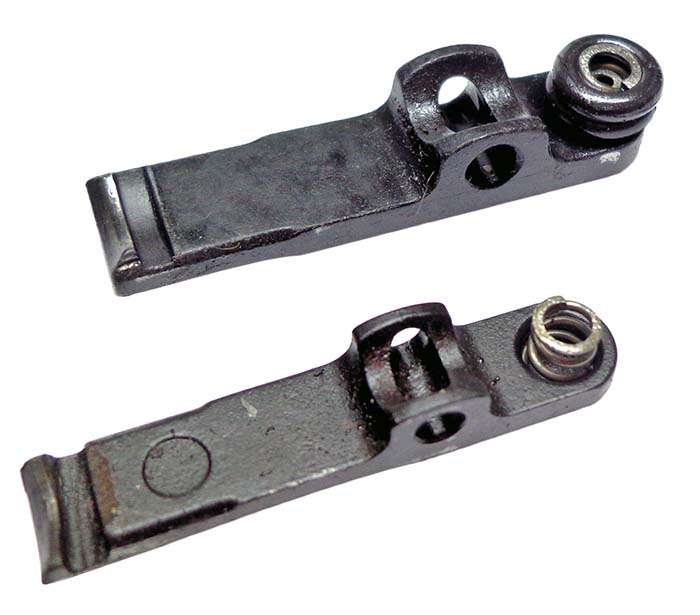
The optics used to test this rifle were the DI Optical Raven 2 red dot sight and 3x magnifier. The Raven 2 has a rugged 30mm objective lens with multi-layer anti-reflective scratch resistant coating. The quality of this sight exceeds Mil-Std 810. The 32mm objective lens provides very good clarity in low level light conditions as well as a wide field of view. The sight is activated by, and intensity of the dot is controlled by, buttons on the left side of the sight. The sight is water resistant up to 30 feet and powered by a single AA battery. The body of the sight is manufactured from 6061-T6 aluminum and hard coat anodized to a flat black color. With an adjustable range of 150 clicks, this 2 MOA dot has an operating range of -32° to 160° Fahrenheit. This particular sight is also night vision compatible. The optic has a 1x magnification. The overall weight of the optic, mount and dust caps is 14.87 ounces. Additionally, the DI Optics 3XP 3x magnifier is attached to an A.R.M.S., Inc. #78 T.I.T.S. (Tangent Integrated Tilt Sight) mount. The mount allows for the magnifier to tilt 30 degrees permitting use of the optic and when longer range is needed the magnifier is moved to the engaged position. The housing of the magnifier is also manufactured from 6061-T6 aluminum and hard coat anodized to a flat black color. The overall weight of the magnifier is 11.08 ounces. Like the optic, the magnifier also has an operating range of -32° to 160° Fahrenheit and is water resistant up to 30 feet in water. The magnifier has an adjustable diopter (-2~+2) and vertical and horizontal centering knobs. This magnifier also conforms to Mil-Std 810 like the Raven 1 optic. The sight has a wide range of click movements (100 clicks). The ocular lens is 28mm in diameter. Together the optic and magnifier make for a very effective package. When in close quarter only the optic is engaged and when distance is needed the magnifier is engaged giving a complete 4x optic, which is ideal for the range of a military small arm. The quality is very good, certainly up to par with their leading competitors. DI Optical is rather new to the gun sight business but with the quality seen, they will be an excellent choice for whatever the shooter’s need is.
Ammunition was provided by Wolf, Tula, Federal and Winchester. The Wolf is the 123gr full metal jacket with a polyformance coated steel cartridge case. The Tula is a 122gr full metal jacket also loaded in a polyformance coated steel cartridge case. The Federal ammunition is American Eagle 124gr full metal jacket (A76239A). The Winchester ammunition is from the PDX1 Defender line of ammunition loaded with a 120gr split core hollow point projectile loaded into a nickel plated cartridge case. This round also has a low flash propellant.
When testing began, the rifle used the standard GI-type trigger mechanism the rifle came with. There were no misfires with any of the ammunition tested. The EDT trigger was installed with the lighter 4 1/2 pound hammer spring and there were light strikes found periodically with the Wolf and Tula ammunition. It was clear they used very hard primers compared to the Federal and Winchester ammunition. The spring was switched over to the red 5 1/2 pound spring and there were no further issues. These problems would not be found firing a vast majority of 5.56mm/.223 Rem. ammo but the Russian 7.62x39mm had some real hard primers. The trigger pull was vastly superior to that of the standard in pull and trigger break. This is definatly an upgrade. Of all the ammunition tested the Federal American Eagle printed slightly better than the rest. Due to the brisk 3° day with a – 13° degree wind chill, shooting precise targets was quite difficult. The recoil of the rifle was pleasant and notably better than that of the Kalashnikov counterpart. The rifle experienced no malfunctions in the nearly 700 rounds that were put through it. Due to the use of the proper magazine, there were no failures to feed noted. The optics were excellent and maintained under 1-inch groups at the 25 yard range the rifle was tested on.
The Mk47 is an excellent rifle. It truly is a mutant that breaches the best of both worlds. The larger bolt and the use of the proper magazine are the keys to the reliability. The only criticism this author could find is that the AR-style charging handle was quite inconvenient to have to change grip to pull the bolt back every time I would reload. This rifle could have benefited to a charging handle on the right side of the bolt like an AK47. With a standard M16 or M4, most of the bolt release is done with the bolt catch and not the charging handle. Due to the bolt catch not being available of the Mk47, the charging handle was the only option. Other than that the rifle fed all the different magazines it was given as well as all the ammunition. This rifle could serve many roles; competition, target shooting, patrol rifle as well as a hunting rifle. It is sure to please the one who likes the 7.62x39mm cartridge but does not like the limitations of the AK platform. The Mk47 is light weight, reliable and accurate enough for most any use it would be called upon to perform.
| This article first appeared in Small Arms Review V20N6 (July 2016) |












